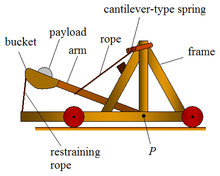
Back Katapult Afrikaans Katapult ALS منجنيق Arabic Catapulta AST Katapult Azerbaijani Катапульта Byelorussian Катапулт Bulgarian Katapult (oružje) BS Catapulta Catalan Katapult (stroj) Czech

A catapult is a ballistic device used to launch a projectile a great distance without the aid of gunpowder or other propellants – particularly various types of ancient and medieval siege engines.[1] A catapult uses the sudden release of stored potential energy to propel its payload. Most convert tension or torsion energy that was more slowly and manually built up within the device before release, via springs, bows, twisted rope, elastic, or any of numerous other materials and mechanisms.
In use since ancient times, the catapult has proven to be one of the most persistently effective mechanisms in warfare. In modern times the term can apply to devices ranging from a simple hand-held implement (also called a "slingshot") to a mechanism for launching aircraft from a ship.
The earliest catapults date to at least the 7th century BC, with King Uzziah, of Judah, recorded as equipping the walls of Jerusalem with machines that shot "great stones".[2] Catapults are mentioned in Yajurveda under the name "Jyah" in chapter 30, verse 7.[3] In the 5th century BC the mangonel appeared in ancient China, a type of traction trebuchet and catapult.[4][5] Early uses were also attributed to Ajatashatru of Magadha in his, 5th century BC, war against the Licchavis.[6] Greek catapults were invented in the early 4th century BC, being attested by Diodorus Siculus as part of the equipment of a Greek army in 399 BC, and subsequently used at the siege of Motya in 397 BC.[7][8]
- ^ Gurstelle, William (2004). The art of the catapult: build Greek ballista, Roman onagers, English trebuchets, and more ancient artillery. Chicago: Chicago Review Press. ISBN 978-1-55652-526-1. OCLC 54529037.
- ^ "Bible, King James Version". quod.lib.umich.edu. Retrieved 2022-01-19.
- ^ Full text of "The Yajur Veda"
- ^ Cite error: The named reference
Cheveddenwas invoked but never defined (see the help page). - ^ Cite error: The named reference
Trebuchetwas invoked but never defined (see the help page). - ^ Singh, U. (2008). A History of Ancient and Early Medieval India: From the Stone Age to the 12th Century. Pearson Education. p. 272. ISBN 9788131711200. Archived from the original on July 3, 2014. Retrieved October 5, 2014.
- ^ Diod. Sic. 14.42.1.
- ^ Campbell, Duncan (2003), Greek and Roman Artillery 399 BC – AD 363, p.3"
© MMXXIII Rich X Search. We shall prevail. All rights reserved. Rich X Search